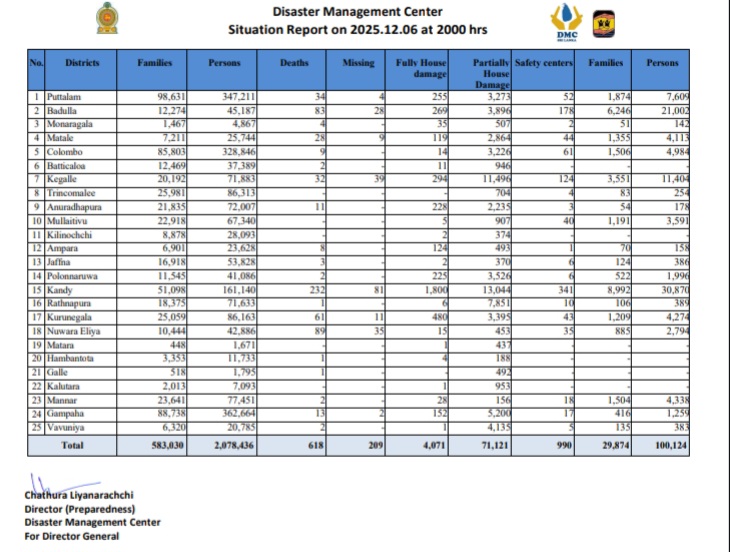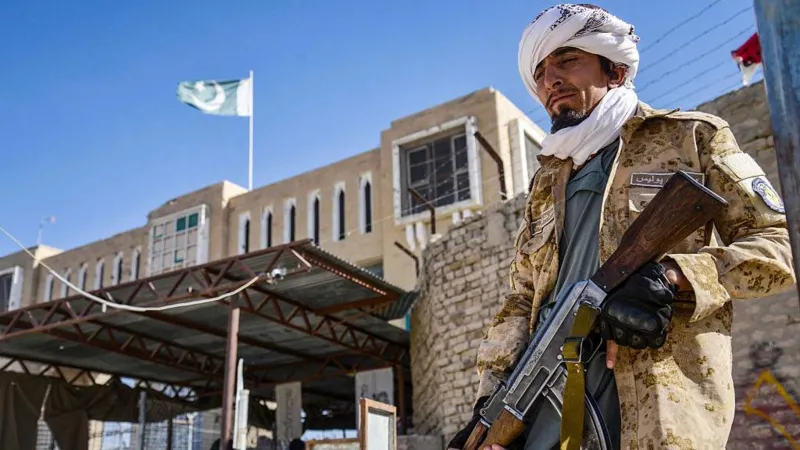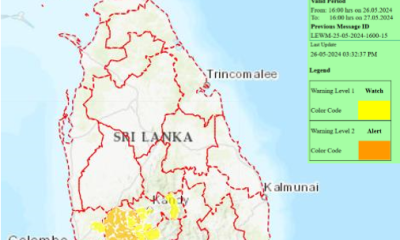Latest News
“Release urgent funds for weather-affected relief” – President directs Finance Secretary

- Steps towards Rebuilding Devastated Homes.
- Government Allocated Funds for Reconstruction.
- Security Forces and Government Officials Lead Relief Efforts.
- Full Engagement in Restoration Efforts.
- Continuous Support for Shelter Residents.
- On-going Provision of Food and Healthcare.
- 24/7 Emergency Hotline for Disaster Assistance- President Commends Dedication of Relief Workers.
President Ranil Wickramasinghe directed the Secretary of the Ministry of Finance to immediately release the necessary funds to the relevant District Secretaries to provide urgent relief to the victims of the recent disaster caused by adverse weather conditions following this year’s southwest monsoon.
Additionally, the President has instructed the concerned parties to rebuild all houses that were completely destroyed by the disaster, with assistance from the government, tri- forces, and police, within the next two months.
A comprehensive plan for this initiative will be implemented under the leadership of Senior Adviser to the President on National Security and Chief of the Presidential Staff Sagala Ratnayake and President’s Secretary Saman Ekanayake.
Currently, the Ministry of Public Administration, the Ministry of Defence, tri-forces, the police, the Civil Defence Department, the Disaster Management Centre, the District Secretariats, and the essential officers of all affected Divisional Secretariats, along with Divisional Disaster Management Officers led by Grama Niladhari Officers, are working to provide relief to the affected.
The President, appreciating the dedication of all the officers, stated that the government would immediately provide all necessary support to the public to maintain a normal quality of life and ensure the continuation of essential services.
Retired Major General Adeepa Thilakarathne, the Acting Director General of the Disaster Management Centre, mentioned that he received instructions during a discussion held on Sunday (02) for the full implementation of the District Disaster Management Centres under the 25 District Secretariats. He also mentioned that they agreed to provide the necessary support equipment from the Tri-forces, Police, and Civil Defence Department, including operational vehicles, boats, and helicopters for use in flood situations. He pointed out that the Navy, Air Force, and Army are fully committed to this effort.
The meeting was attended by State Minister for Defence Pramitha Bandara Thennakoon, Senior Adviser to the President on National Security and Chief of the Presidential Staff Sagala Ratnayake, and Defence Secretary (Retired) General Kamal Gunarathne, with District Secretaries from high-impact areas joining via electronic means.
The Acting Director General of the Disaster Management Centre requested the public to avoid unnecessary travel, stay away from areas damaged by floods or disasters, and refrain from water sports in flooded or waterlogged areas.
The Disaster Management Centre’s emergency hotline, 117, is operational 24/7 to report emergencies and provide further assistance to those affected. The Acting Director General emphasized that all relevant government institutions and officials will be coordinated and supported to ensure effective service delivery.
Rathnapura District Secretary, Wasantha Gunarathne, reports that eight high-risk Divisional Secretariat Divisions have been identified in the Rathnapura district, with disaster relief officers in all these offices working full-time. The identified high-risk areas are Ratnapura, Kuruwita, Alapatha, Kalawana, Ayagama, Kiriella, Nivithigala, and Eheliyagoda.
As on Sunday (02), 9,398 people from 2,574 families have been affected by the adverse weather conditions, with 2,219 individuals from 528 families sheltering in 18 relief centres. So far, five deaths have been reported in the Rathnapura district. Mr. Gunarathne states that the collaboration between Divisional Secretaries, GN Officers, and other local authorities has made the disaster relief efforts more efficient.
The Rathnapura District Secretary also emphasized that the food and health needs of all victims, both inside and outside the displaced persons camps, are being well met.
Meanwhile, Galle Acting District Secretary, Mrs. C.T. Rajakaruna, reported that out of the 22 Divisional Secretariats, the seven most at-risk areas are Neluwa, Thavalama, Nagoda, Niagama, Welivitiya Divithura, Baddegama, and Elpitiya. She noted that the impact associated with the adverse weather is decreasing. However, 3,455 people from 1,348 families have been affected by the disaster, and two people are currently missing. The Acting District Secretary assured that all necessary facilities have been provided for 608 people from 250 families at one main safety center.
Matara District Secretary, Ganesh Amarasinghe, reports that among the 16 Divisional Secretariat Divisions, Athuraliya, Akurassa, and Pitabeddara are in a state of extreme danger. Mulatiyana, Pasgoda, Kotapola, Thihagoda, and Malimbada have also been affected, while other divisions have suffered minor impacts. The calamities have resulted in the deaths of three people and two individuals are missing. A total of 10,937 people from 2,731 families have been affected. Additionally, 150 houses have been damaged in the Matara district. Currently, 123 people from 21 families are staying in five shelters and receiving necessary facilities. He assured that all required amenities have been provided to the disaster victims and mentioned receiving directives from the Ministry of Public Administration and the President’s Office to offer any further necessary services.
In Kaluthara district, 943 families have been affected by the disaster, displacing 3,539 people. Kaluthara District Secretary, Prasanna Janaka Kumara, stated that 30 shelters have been established, accommodating 2,274 people from 606 families with necessary facilities.
Disaster situations have been reported in just six Divisional Secretariat Divisions of the Colombo District, leading to the displacement of 6,839 individuals from 1,716 families. Acting District Secretary, Prasanna Janaka Kumara, stated that seven safe shelters have been set up by the Divisional Secretaries, accommodating 215 people from 58 families.
(PMD)
Latest News
Landslide RED warnings issued to the districts of Kandy, Kegalle, Kurunegala, Matale and Nuwara Eliya extended up to 1600 hrs today [07]

The Landslide Early Warning Center of the National Building Research Organisation [NBRO] has issued landslide early warnings to the districts of Badulla, Colombo, Galle, Gampaha, Kalutara, Kandy, Kegalle, Kurunegala, Matale, Matara, Monaragala, Nuwara Eliya and Ratnapura effective from 16:00 hrs on 06.12.2025 to 16:00 hrs on 07.12.2025.
Accordingly,
LEVEL III RED warnings have been issued to the Divisional Secretaries Divisions and surrounding areas of Pathadumbara, Kundasale, Pathahewaheta, Panvila, Medadumbara, Doluwa, Thumpane, Udunuwara, Deltota, Ganga Ihala Korale, Pasbage Korale, Yatinuwara, Hatharaliyadda, Ududumbara, Minipe, Udapalatha, Gangawata Korale, Akurana, Poojapitiya and Harispattuwa in the Kandy district, Thumpane, Udunuwara, Deltota, Ganga Ihala Korale, Pasbage Korale, Yatinuwara, Hatharaliyadda, Ududumbara, Minipe, Udapalatha, Gangawata Korale, Akurana, Poojapitiya and Harispattuwa in the Kegalle district, Alawwa, Rideegama, Polgahawela, Mallawapitiya and Mawathagama inthe Kurunegala district, Ukuwela, Naula, Yatawatta, Laggala Pallegama, Pallepola, Matale, Rattota, Ambanganga Korale and Wilgamuwa in the Matale district, and Hanguranketha, Mathurata, Nildandahinna and Walapane in the Nuwara Eliya district
LEVEL II AMBER warnings have been issued to the Divisional Secretaries Divisions and surrounding areas of Uva Paranagama, Badulla, Kandeketiya, Bandarawela, Soranathota, Hali_Ela, Meegahakivula, Ella, Welimada, Haputhale, Lunugala, Haldummulla and Passara in the Badulla district, Narammala in the Kurunegala district, Kothmale West, Norwood, Ambagamuwa Korale, Thalawakele, Kothmale East and Nuwara Eliya in the Nuwara Eliya district and Godakawela, Kahawaththa and Kolonna in the Ratnapura district.
LEVEL I YELLOW warnings have been issued to the Divisional Secretaries Divisions and surrounding areas of Seethawaka and Padukka in the Colonbo district, Elpitiya and Yakkalamulla in the Galle district, Mirigama, Divulapitiya and Attanagalla in the Gampaha district, Ingiriya, Bulathsinhala and Horana in the Kalutara district, Pasgoda and Athuraliya in the Matara district, Bibile and Medagama in the Monaragala district, and Kuruwita, Balangoda, Eheliyagoda, Pelmadulla, Kaltota, Kalawana, Openayake, Ayagama, Nivithigala, Imbulpe, Elapatha, Ratnapura and Kiriella in the Ratnapura district.
Latest News
618 dead, 209 missing as at 2000hrs on Saturday [06]

The Situation Report issued by the Disaster Management Center [DMC] at 2000hrs on Saturday [06] confirms that 607 persons have died due to the recent flooding and landslides while another 209 persons were missing.
The death toll in the Kandy district which one of the most affected districts has risen to 232, and 1800 houses have been fully damaged.The number of missing persons reported is 81
100,124 persons belonging to 29,874 families were being housed at 990 safety centers established by the government.

Foreign News
Deadly border fighting breaks out between Pakistan and Afghanistan

Border clashes have erupted again between Pakistan and Afghanistan’s Taliban forces, with each sides accusing the other of breaking a fragile ceasefire.
Residents fled the Afghan city of Spin Boldak overnight, which lies along the 1,600-mile (2,600 km) border between the two countries.
A medical worker in the nearby city of Kandahar told BBC Pashto that four bodies had been brought to a local hospital. Four other people were wounded. Three were reportedly wounded in Pakistan.
There has been sporadic fighting between the two countries in recent months, while Afghanistan’s Taliban government has also accused Pakistan of carrying out air strikes inside the country.
Both sides have confirmed they exchanged fire overnight but each blamed the other for initiating the four hours of fighting.
Mosharraf Zaidi, a spokesperson for Pakistan’s Prime Minister Shehbaz Sharif, accused the Taliban of “unprovoked firing”.
The statement continued: “An immediate, befitting & intense response has been given by our armed forces. Pakistan remains fully alert & committed to ensuring its territorial integrity & the safety our citizens.”
Meanwhile, a Taliban spokesperson said Pakistan had “once again initiated attacks” and said it was “forced to respond”.
Residents on the Afghan side of the border said the exchange of fire started at around 22:30 (18:00 GMT) on Friday.
Footage from the area showed a large number of Afghans fleeing on foot and in vehicles.
Ali Mohammed Haqmal, head of Kandahar’s information department, said Pakistan’s forces had attacked with “light and heavy artillery” and civilian homes had been hit by mortar fire.
The latest clashes came less than two months after both sides agreed to a ceasefire mediated by Qatar and Turkey.
It ended more than a week of fighting in which dozens were killed – the worst clashes between Pakistan and the Taliban since the group returned to power in 2021 – though tensions have remained high.
The government in Islamabad has long accused Afghanistan’s ruling Taliban of giving shelter to armed groups which carry out attacks in Pakistan.
The Taliban government denies the accusation and has accused Pakistan of blaming others for their “own security failures”.
The Pakistan Taliban have carried out at least 600 attacks on Pakistani forces over the past year, according to the Armed Conflict Location & Event Data Project.
Last week delegations from both sides met in Saudi Arabia for a fourth round of negotiations on a wider peace settlement, but did not reach an agreement.
Sources familiar with the talks told BBC News that both sides had agreed to continue with the ceasefire.
[BBC]
-
News4 days ago
Lunuwila tragedy not caused by those videoing Bell 212: SLAF
-

 News3 days ago
News3 days agoLevel III landslide early warning continue to be in force in the districts of Kandy, Kegalle, Kurunegala and Matale
-

 Latest News5 days ago
Latest News5 days agoLevel III landslide early warnings issued to the districts of Badulla, Kandy, Kegalle, Kurunegala, Matale and Nuwara-Eliya
-

 Features5 days ago
Features5 days agoDitwah: An unusual cyclone
-

 Latest News6 days ago
Latest News6 days agoUpdated Payment Instructions for Disaster Relief Contributions
-

 News1 day ago
News1 day agoCPC delegation meets JVP for talks on disaster response
-

 News1 day ago
News1 day agoA 6th Year Accolade: The Eternal Opulence of My Fair Lady
-

 Latest News6 days ago
Latest News6 days agoLandslide Early Warnings issued to the Districts of Badulla, Colombo, Gampaha, Kalutara, Kandy, Kegalle, Kurunegala, Matale, Moneragala, Nuwara Eliya and Ratnapura

























